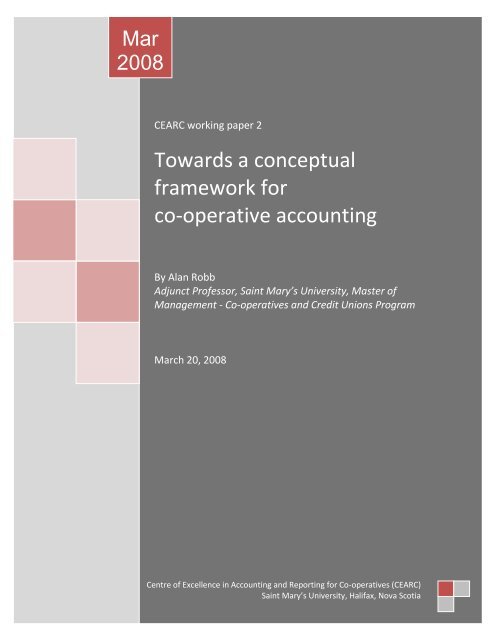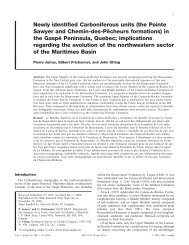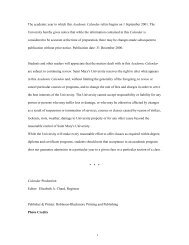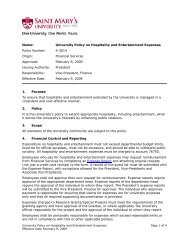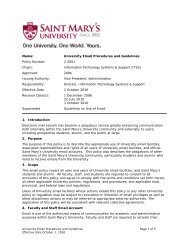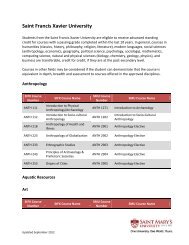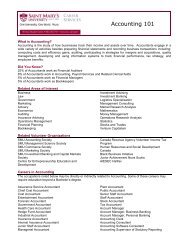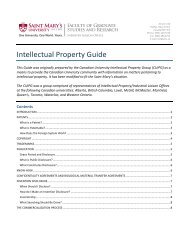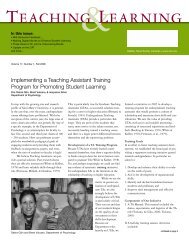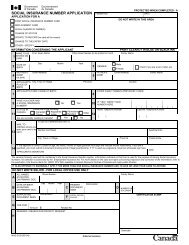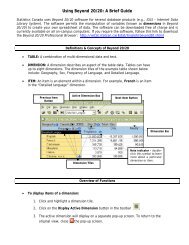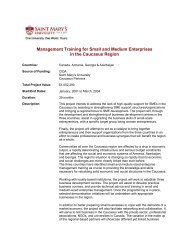Conceptual framework of cooperative accounting
Conceptual framework of cooperative accounting
Conceptual framework of cooperative accounting
Create successful ePaper yourself
Turn your PDF publications into a flip-book with our unique Google optimized e-Paper software.
Mar<br />
2008<br />
CEARC working paper 2<br />
Towards a conceptual<br />
<strong>framework</strong> for<br />
co-operative <strong>accounting</strong><br />
By Alan Robb<br />
Adjunct Pr<strong>of</strong>essor, Saint Mary’s University, Master <strong>of</strong><br />
Management - Co-operatives and Credit Unions Program<br />
March 20, 2008<br />
Centre <strong>of</strong> Excellence in Accounting and Reporting for Co-operatives (CEARC)<br />
Saint Mary’s University, Halifax, Nova Scotia
CEARC working paper 2<br />
Towards a conceptual<br />
<strong>framework</strong> for co-operative<br />
<strong>accounting</strong><br />
CONTENTS<br />
March 20, 2008<br />
The Centre <strong>of</strong> Excellence in<br />
Accounting and Reporting for<br />
Co-operatives (CEARC) is<br />
sponsored by:<br />
• Saint Mary’s University<br />
• Canadian Institute <strong>of</strong><br />
Chartered Accountants<br />
• The Co-operators<br />
• Midcounties Co-operative<br />
(UK)<br />
• Co-operatives Branch –<br />
Service Nova Scotia and<br />
Municipal Relations<br />
• Co-operative Housing<br />
Federation<br />
• United Farmers <strong>of</strong> Alberta<br />
• Nova Scotia Co-operative<br />
Council<br />
• Scotsburn Dairy<br />
1. Background 2<br />
2. Structure <strong>of</strong> the IASB/FASB<br />
conceptual <strong>framework</strong><br />
3. A conceptual <strong>framework</strong> for<br />
co-operatives<br />
4. References 8<br />
5. Questions for feedback 9<br />
3<br />
4<br />
Published by CEARC<br />
Department <strong>of</strong> Management<br />
Sobey School <strong>of</strong> Business<br />
Saint Mary’s University<br />
Sobey Building, Robie Street<br />
Halifax, Nova Scotia B3H 3C3<br />
©CEARC, 2008<br />
Executive Director:<br />
John Maddocks<br />
E-mail: john.maddocks@smu.ca<br />
Website:<br />
www.coop<strong>accounting</strong>.coop
1. BACKGROUND<br />
Comments received on CEARC working paper 1 included the suggestion that a desirable first<br />
step in the development <strong>of</strong> an iSORP for co-operatives is the enunciation <strong>of</strong> a conceptual<br />
<strong>framework</strong>. This is logical. A conceptual <strong>framework</strong> which is internally consistent and which<br />
defines basic concepts can lead to <strong>accounting</strong> standards and SORPs which are principlesbased<br />
and consistent with each other.<br />
The International Accounting Standards Board (IASB) and the Financial Accounting Standards<br />
Board (FASB) are developing a common conceptual <strong>framework</strong> which, it is hoped, will improve<br />
upon the existing conceptual <strong>framework</strong>s <strong>of</strong> both boards.<br />
However, the IASB standard setting process is increasingly being criticized for its focus on the<br />
information needs <strong>of</strong> investors in large corporations. The idea that such standards can be<br />
„sector neutral‟, or equally applicable to all entities, has been seriously challenged by the New<br />
Zealand Controller & Auditor General (Brady, 2007).<br />
Brady noted that the reporting issues <strong>of</strong> most relevance to the public sector, such as the<br />
reporting <strong>of</strong> non-financial performance, were not being addressed; the IASB is unlikely to have<br />
considered types <strong>of</strong> non-commercial arrangements frequently encountered in the public sector,<br />
and that there are standards that need to be written just for the public sector that are not<br />
applicable to pr<strong>of</strong>it-oriented entities.<br />
In each case Brady‟s comments apply equally appropriately to co-operatives and other entities<br />
in what may be described as the association sector (Mintzberg, Molz, Raufflet, Sloan, Abdallah,<br />
Bercuvitz & Tzeng, 2005).<br />
Brady noted with approval that the International Public Sector Accounting Standards Board<br />
(IPSASB) is in the process <strong>of</strong> developing a <strong>framework</strong> for standard setting in the public sector.<br />
He believed it likely that the <strong>framework</strong>s underpinning the IASB and IPSASB standards would<br />
ultimately contain “significant differences”.<br />
Again, Brady‟s comment applies equally appropriately to co-operatives and the association<br />
sector.<br />
After careful and extensive discussion, it was decided that this <strong>framework</strong> would generally follow<br />
the structure <strong>of</strong> the IASB <strong>framework</strong> but the wording should be written more simply in order that<br />
it has the greatest relevance to co-operatives and may better lead to the development <strong>of</strong> a<br />
Statement <strong>of</strong> Recommended Practice for Co-operatives.<br />
CEARC Mar 2008<br />
2
2. STRUCTURE OF THE IASB/FASB CONCEPTUAL FRAMEWORK<br />
The IASB <strong>Conceptual</strong> Framework is being prepared in eight phases:<br />
Phase<br />
A<br />
B<br />
C<br />
D<br />
E<br />
F<br />
G<br />
H<br />
Topic<br />
Objectives and qualitative characteristics<br />
Elements and recognition<br />
Measurement<br />
Reporting entity<br />
Presentation and disclosure<br />
Purpose and status<br />
Application to not-for-pr<strong>of</strong>it entities<br />
Remaining Issues, if any<br />
It seems likely that the final format <strong>of</strong> the Framework may differ in sequence, „Purpose and<br />
Status‟ being the logical opening section <strong>of</strong> a Framework and „Remaining Issues if any‟ being<br />
incorporated elsewhere in the document.<br />
CEARC Mar 2008<br />
3
3. A CONCEPTUAL FRAMEWORK FOR CO-OPERATIVES<br />
This conceptual <strong>framework</strong> is ordered in the following sequence:<br />
• Purpose<br />
• Objectives and qualitative characteristics<br />
• Elements and recognition<br />
• Measurement<br />
• Reporting entity<br />
• Presentation and Disclosure<br />
In the following sections Arial type is used to designate the formal paragraphs <strong>of</strong> the conceptual<br />
<strong>framework</strong> with italics used for explanatory paragraphs.<br />
Purpose<br />
1. This <strong>framework</strong> sets out the concepts that underlie the preparation and presentation <strong>of</strong><br />
financial reports for members <strong>of</strong> co-operatives.<br />
Co-operatives operate on the principles <strong>of</strong> user-ownership, user-control and proportional<br />
distribution. They differ in many significant ways from investor-owned corporations.<br />
Consequently there is a need for a specific <strong>Conceptual</strong> Framework for Co-operatives.<br />
Objectives and qualitative characteristics<br />
2. Financial reports <strong>of</strong> co-operatives are designed to provide retrospective and<br />
contemporary financial information that is a guide to future action and to be a report <strong>of</strong><br />
stewardship to members.<br />
3. Financial reports will be serviceable if the data is representationally faithful and<br />
presented in a timely manner. This is the most fundamental principle.<br />
In order to be representationally faithful, data should correspond with observable evidence<br />
and be free from allocations.<br />
Non-financial data is also <strong>of</strong> significance in reports <strong>of</strong> stewardship and in understanding<br />
financial data. The expression ‘financial reports’ is intended to encompass both financial<br />
and non-financial data.<br />
Elements and recognition<br />
4. The following elements are integral to the development <strong>of</strong> standards that are principlesbased,<br />
internally consistent and lead to financial reporting that provides information <strong>of</strong> use to<br />
members <strong>of</strong> a co-operative.<br />
CEARC Mar 2008<br />
4
Financial position: the ability <strong>of</strong> the entity to engage in indirect exchanges in the<br />
market place. It is measured by the monetary value in exchange <strong>of</strong> the assets and<br />
the monetary value in exchange <strong>of</strong> the liabilities as at a stated date. Financial<br />
position changes as a result <strong>of</strong> transactions, transformations and events.<br />
Transactions: exchanges consciously entered into.<br />
Transactions are the most common cause <strong>of</strong> changes in financial position in any <strong>cooperative</strong><br />
(or other entity).<br />
Transformations: changes made to the form <strong>of</strong> assets held by an entity.<br />
Transformations are common in manufacturing co-operatives (or other entities<br />
which process raw materials). Successful transformations will add value,<br />
unsuccessful transformations will destroy it. Regular revaluations to fair value<br />
recognize the value added or destroyed.<br />
Events: external occurrences which affect either the form in which assets or<br />
liabilities are held or the monetary unit in which they are expressed.<br />
Events, such as storms or fires, can have an adverse impact on financial position<br />
because <strong>of</strong> their effect on assets. Other events, such as a movement in foreign<br />
exchange rates or the rezoning <strong>of</strong> property, may have either a positive or negative<br />
effect. Traditionally only adverse events were recognized, on the grounds <strong>of</strong><br />
conservatism. This view is now passing and it is recognized that financial reporting<br />
can be representationally faithful only if all events, whether favourable or<br />
unfavourable, are reported as they occur.<br />
Assets: the severable resources in the possession <strong>of</strong> an entity.<br />
To be consistent with the fundamental principle <strong>of</strong> representational faithfulness and<br />
to be serviceable in providing information that assists action in markets, assets can<br />
only comprise property or property rights recognized by law.<br />
Liabilities: the present obligations <strong>of</strong> an entity to non-members.<br />
Equity: the interest <strong>of</strong> members in the assets <strong>of</strong> the entity. It may be either<br />
allocated equity (which may be withdrawn when the member leaves the <strong>cooperative</strong>)<br />
or unallocated equity (which remains in the co-operative when the<br />
member leaves).<br />
Income: revenue and gains accruing to the entity whether from operating activities<br />
or elsewhere.<br />
Income is the gross inflow <strong>of</strong> resources other than from borrowing or from direct<br />
contributions from members. (Note, this is an inflow on an accrual basis, not a cash<br />
basis).<br />
CEARC Mar 2008<br />
5
Expenses: outflows or depletions <strong>of</strong> assets whether arising from operating activities<br />
or other causes.<br />
Expenses and losses are diminutions in assets other than those caused by the<br />
repayment <strong>of</strong> liabilities or by distributions to members.<br />
Patronage rebate: a distribution made to a transacting shareholder in relation to<br />
that person‟s transactions with the co-operative over a period. It may be made<br />
partly in cash and partly in shares or other financial instruments as part <strong>of</strong> a capital<br />
redemption plan.<br />
Investor shares: shares on which dividends are paid as a return on investment and<br />
not as a patronage rebate.<br />
Member shares: shares which confer membership <strong>of</strong> a co-operative. In some <strong>cooperative</strong>s<br />
these are held in conjunction with transactor shares.<br />
Transactor shares: shares issued which entitle the holder to a patronage rebate.<br />
5. Recognition. Financial position changes as a result <strong>of</strong> transactions, transformations<br />
and events. Financial statements should recognize all changes that can be reliably<br />
measured in a cost effective manner.<br />
Measurement<br />
6. In order to provide financial information that is both internally consistent and relevant<br />
for action all assets should be revalued regularly to fair value. Fair value is the net<br />
realizable value in the ordinary course <strong>of</strong> business.<br />
Knowledge <strong>of</strong> the fair value <strong>of</strong> assets is part <strong>of</strong> the information which is necessary to<br />
establish whether the co-operative is solvent. It may also be relevant for calculating the<br />
fair value <strong>of</strong> shares in the co-operative.<br />
7. The Income Statement should be all-inclusive. All revaluations should be recognized<br />
in the Income Statement as they affect financial position <strong>of</strong> the co-operative as much as<br />
gains or losses from other transactions, transformations or events.<br />
The constitutions <strong>of</strong> co-operatives may specify that revaluations be allocated to<br />
members when recognized, or retained as unallocated pr<strong>of</strong>its, or be distributed only to a<br />
designated type <strong>of</strong> charity on a winding up. This latter provision is designed to<br />
safeguard the co-operative against demutualization by individuals seeking windfall<br />
gains. The principle <strong>of</strong> disposal <strong>of</strong> net assets without pr<strong>of</strong>it to members was a<br />
constitutional requirement <strong>of</strong> the Rochdale Pioneers from 1854 and in some countries<br />
today, such as France, is currently a legal requirement.<br />
CEARC Mar 2008<br />
6
Reporting Entity<br />
8. Where a co-operative has one or more subsidiaries or has a material interest in<br />
another entity, group data should be presented in addition to the co-operative‟s own<br />
financial statements. The group data need not be presented in consolidated form<br />
unless that form <strong>of</strong> presentation faithfully presents the obligations <strong>of</strong> the co-operative.<br />
Financial statements which consolidate related entities whose liabilities are guaranteed<br />
together with related entities whose liabilities are not guaranteed cannot be a<br />
representationally faithful presentation <strong>of</strong> the obligations <strong>of</strong> the co-operative. Alternative<br />
presentations, such as separate supplementary reports, should be used.<br />
Presentation and Disclosure<br />
9. Financial reports should be prepared with due regard for materiality <strong>of</strong> the figures<br />
presented. Notes to the reports should be used to ensure that the information<br />
presented is understandable and neutral or free from bias.<br />
10. In order to be useful to members, financial reports should comprise a balance sheet<br />
or statement <strong>of</strong> financial position, an income statement, and a statement <strong>of</strong> cash flows.<br />
Comparative data for the preceding periods should be shown.<br />
Comparative figures in an annual report would be for the previous financial year(s). In a<br />
half-yearly report it would be relevant to show comparative data for the corresponding<br />
half-year and for the previous full year.<br />
Alternative names <strong>of</strong> the component parts <strong>of</strong> the financial report such as Pr<strong>of</strong>it & Loss<br />
Account and Balance Sheet are equally acceptable.<br />
11. The reports should clearly disclose the benefits <strong>of</strong> membership including the basis<br />
on which rebates are calculated.<br />
In some co-operatives the benefits <strong>of</strong> membership might not be received as rebates. A<br />
health co-operative may provide more accessible service; an education co-operative<br />
may provide improved teacher/student ratios and an enhanced curriculum.<br />
12. The reports should disclose the ways in which it has sought to comply with the<br />
seven co-operative principles <strong>of</strong> the International Co-operative Alliance.<br />
Co-operatives recognize their employees, managers and the community have a<br />
legitimate interest in the operations <strong>of</strong> the co-operative.<br />
13. The financial reports should be accompanied by non-financial information providing<br />
additional reporting on the activities and performance <strong>of</strong> the co-operative. Both the<br />
financial statements and the additional non-financial information should complement<br />
and, where appropriate, inform each other.<br />
CEARC Mar 2008<br />
7
4. REFERENCES<br />
Brady, K. Do NZ IFRS meet the public sector‟s needs? Chartered Accountants<br />
Journal, November 2007: 19-20.<br />
Mintzberg, H., Molz, R., Raufflet, E., Sloan, P., Abdallah, C., Bercuvitz, R., and Tzeng,<br />
C. The Invisible World <strong>of</strong> Association, Leader to Leader, Spring 2005: 37-45.<br />
CEARC Mar 2008<br />
8
5. QUESTIONS FOR FEEDBACK<br />
CEARC is keen to receive feedback concerning any aspect <strong>of</strong> this working paper and including<br />
the ideas and views presented. In particular we would be interested in your views on all or any<br />
<strong>of</strong> the following:<br />
1. Does this working paper omit any key concepts which are necessary in a Statement<br />
<strong>of</strong> Concepts?<br />
2. Does this working paper include any items which should be introduced in the<br />
proposed co-operative international Statement <strong>of</strong> Recommended Practice (iSORP)?<br />
3. What expansion is needed in the items covered in this working paper?<br />
Please send comments in writing by e-mail, mail or fax to:<br />
john.maddocks@smu.ca<br />
John Maddocks<br />
Centre <strong>of</strong> Excellence in Accounting and Reporting for Co-operatives (CEARC)<br />
Management Department<br />
Sobey School <strong>of</strong> Business<br />
Saint Mary‟s University<br />
Sobey Building<br />
Halifax<br />
Nova Scotia<br />
B3H 3C3<br />
Canada<br />
Fax: 001 902 4205119<br />
Please include your name and your organization’s name and address and indicate the<br />
working paper you are commenting on.<br />
Comments should be received by 31 July 2008<br />
CEARC Mar 2008<br />
9
© CEARC, 2008<br />
Published by CEARC<br />
Management Department<br />
Sobey School <strong>of</strong> Business<br />
Saint Mary‟s University<br />
Sobey Building<br />
Robie Street<br />
Halifax<br />
Nova Scotia B3H 3C3<br />
Canada


